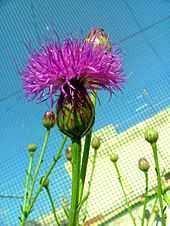Cheirolophus crassifolius
| Cheirolophus crassifolius | |
|---|---|
 | |
| Conservation status | |
| Scientific classification | |
| Kingdom: | Plantae |
| (unranked): | Angiosperms |
| (unranked): | Eudicots |
| (unranked): | Asterids |
| Order: | Asterales |
| Family: | Asteraceae |
| Tribe: | Cynareae |
| Genus: | Cheirolophus |
| Species: | C. crassifolius |
| Binomial name | |
| Cheirolophus crassifolius (Bertol.) Susanna | |
| Synonyms | |
|
Centaurea crassifolia | |

it is only found on land near the sea
Cheirolophus crassifolius, the Maltese Centaury, Maltese Rock-centaury or Widnet il-Baħar, is a species of flowering plant in the Asteraceae family.it is only found on cliffs near the sea where it has the right amount of humidity(like dingli cliffs or ta cancu) It is endemic to Malta, where it has been the national plant of Malta since 1973. Its natural habitats are cliffs and coastal valleys . It is threatened by habitat loss.
It is scarce but widespread in the wild on the western cliffs of Malta, rare on the southern cliffs of Gozo, but frequent as a cultivated species in roundabouts. It is quite common in the limits of Wied Babu in the south east of Malta.
It was first described by Stefano Zerafa, around 1830, as the only species of the monotypic genus Palaeocyanus. However, around the year 2000, it was transferred to Cheirolophus, in the light of genetic studies done in that year. The name Cheirolophus means red head, while crassifolius mean thick leaves. The leaves are succulent and spoon shaped. The variety serratifolia (serrated leaves) is very rare, and only known from Gozo. This species is cultivated due to its national importance. The remaining species of the genus Cheirolophus are Canary Island endemics.
See also
- Maltese Starthistle (Centaurea melitensis)
References
- D. Stevens & E. Lanfranco (2006). "Cheirolophus crassifolius". IUCN Red List of Threatened Species. Version 3.1. International Union for Conservation of Nature. Retrieved July 20, 2007.
